Michael Parkes
Highlights
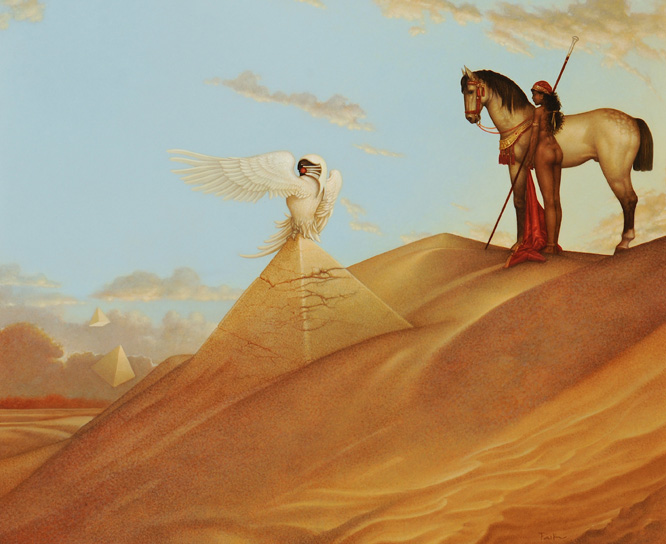
Breaking Illusions
Oil on wood
23.5 x 20 inches
Signed Parkes (lower right)
Year 1999
Art work nr P327
Sold
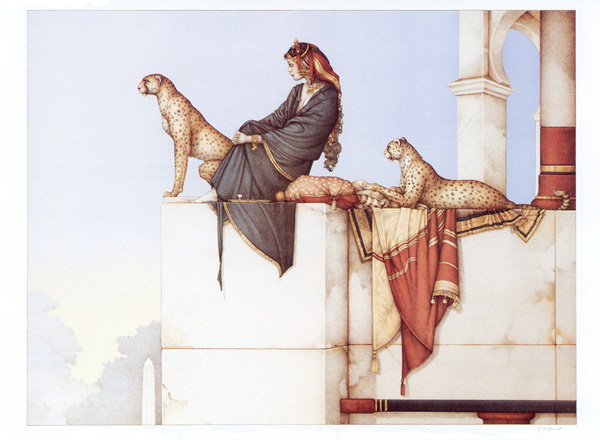
Persepolis
Original hand pulled limited edition stone lithograph
Edition 180
Signed and numbered
Published by Steltman Galleries
Size 27.5 x 35.5 inches
sold
Year 1996
Original Bronze sculpture
Edition 12
Height 42 inches
Sold
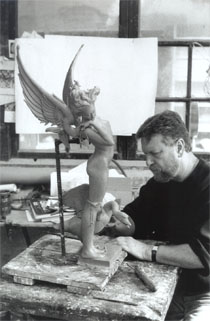
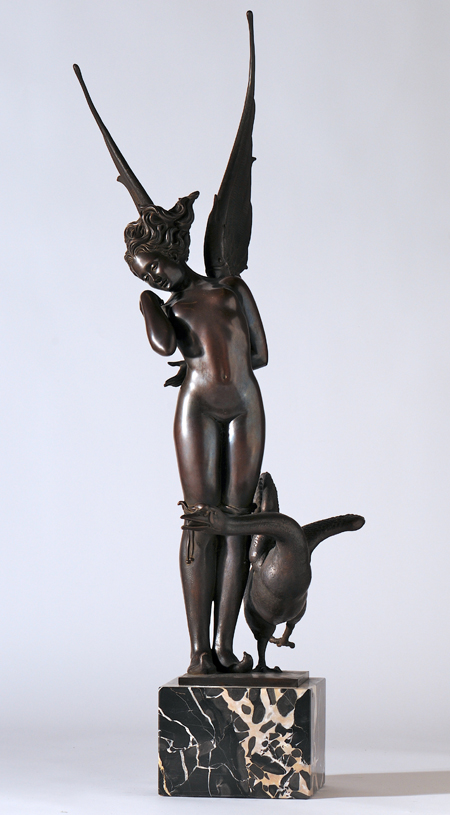
Year 1990
Original oil painting on wood
Size 17 x 19 ¾ inches
Signed Parkes
Art work nr P187
Inquire

Oil on wood 61 x 46 cm
Sold
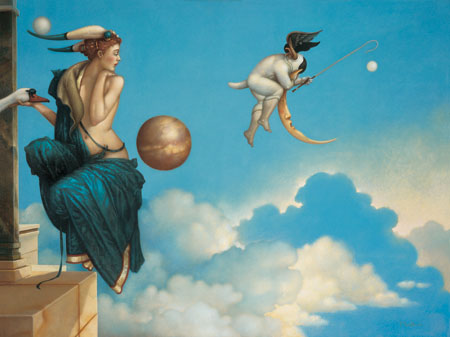
Mixed media
Original oil and pencil
on paperboard
Year: 1991
size: 31 x 21 inch
Signed: Parkes
Art work nr P204
Sold
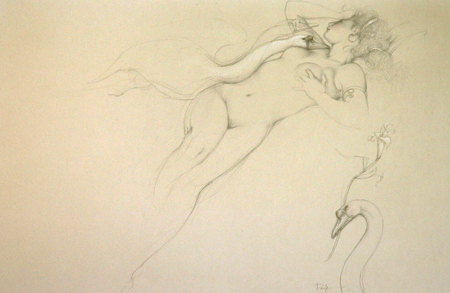
Understanding Michael Parkes
"Take the symbolism for what it is. It is not important to understand or even agree with the symbols I use. What I do want is to offer my art to people to enjoy and enhance their lives with the beauty of colour and light."
As cited by Michael Parkes.
A remarkable quote since what we see in his work is not just a simple figment of his imagination but even so a study of the metaphysical and spiritual principles materialized in his work. His work evokes a mysterious atmosphere, which can often only be deciphered with the help of ancient mythology and eastern philosophy. His work urges us to comprehend instead of just enjoy because part of the enjoyment comes from the understanding of his work.
Of course, his craftsmanship is undeniable; his meticulous style seems sheer drudgery; a monkey's fur coat, almost every hair distinct, a ribbon thrown carelessly in the air as if it were weightless. The paint so thinly applied layer after layer that if painted in one layer it would be translucent. Thus with every stroke of his brush Parkes creates a depth that makes you get drawn into his world.
But it is not immediately his craftsmanship that makes you want to look a second time and makes you wonder. For in a way his technique is subordinate to his imagery. It's a means to an end, a mere translation to capture that what has been formed in his mind. To make the doctrine come alive in such a way that it draws people all over the world in admiration.
His focal point the female form. Sometimes vulnerable and subordinate, mostly powerful and demanding, but always beautiful and mysterious. First you see her beauty then the mystery of her surroundings. Which makes you wonder, what world it is she lives in, why she is there and where she is going. And you realize that you can't answer those questions right away but that you do want to understand. You might think you'd know more by reading the title of the work you are trying to decipher, but it seems to puzzle you exceedingly. You look again at the painting and realize you are captured into the fantasy world of Michael Parkes in which his own laws apply, where past and future do not exist, in which a never ending circle of life, death, birth and rebirth appears.
Parkes felt he needed to travel the world in order to become a complete artist and so he did. He roamed the world and discovered ancient wisdoms, gaining the level of spiritual consciousness he felt he missed to give his work meaning. With the knowledge and skills acquired, Michael Parkes enables the viewer to behold the beauty of magic captivated in his work. Capturing the complete sense of the unexpected; that what is unknown to the viewer in order to make it known, even if it can be seen only for a second.
Doménique van de Kimmenade
Micheal Parkes
Michael Parkes was born in 1944 in Sikeston Missouri (USA) After studying graphic art and painting at the University of Kansas in Lawrence, he taught briefly at Kent State University in Ohio and at the University of Florida. His ultimate goal was to turn his attention to creating art. A child of the hippie generation, he realized, at the age of 24, he needed to see the world in order to be a complete artist.
When he met his wife, Maria, they left the United States. After travelling through Europe, they went to India, Nepal and Pakistan, but it were the experiences he had in India, where he studied philosophy and the esoteric doctrines of the East and the West that were of great influence to his artwork. His imagery is drawn from a range of wisdoms including the cabalistic and the tantric, but embodied in forms from his own imagination which are immediately accessible.
In 1975 Michael Parkes settled definitively in Spain where he engaged in the development of his artwork and where he still lives today. Early on, he painted in the generally abstract expressionist style common among his teachers, but after his pause for reflection he began to draw and paint in a meticulous style of detailed representation which enabled him to give full expression to his inner world of images. Here strange beasts encounter mysterious winged women, good and evil fight out their immemorial conflict and in this weightless environment worlds are unmade and remade nearer to the heart's desire. Even as a student Parkes was fascinated by various graphic processes, and until 2002 he was highly proficient in the difficult medium of the colour stone lithograph.
Bronzes
Technique
Michael Parkes had his first one-man show at Steltman Galleries back in 1977.
Steltman Galleries made one-man exhibitions of Michael Parkes at Basel Art in Switzerland, Art Chicago, Art Fair NY, Frankfurt Bookfair, Amsterdam Art Fair, Tefaf Art and Antiques Fair Maastricht and numerous exhibitions in their galleries in Amsterdam and New York from 1977 onwards. The Limited edition bronze sculptures released by Steltman Galleries.
The technique which Michael Parkes uses to make bronzes is called 'cire perdue': ('lost wax' in French'). After some sketches on what the bronze should look like, Michael Parkes creates a model of hard wax by hand. He chooses hard wax instead of soft wax ( which would make the procedure more fast ) for the original forms because the fine details can be done only in hard wax.
When this model is finished, a silicone paste is sprayed on. This siliconeform is called the contra-mould. This silicone mould will be reused for making each of the wax models that have to be melted for each bronze. For each bronze they make a second wax model in the silicone mould by pouring hot soft wax in the silicone mould that is supported by a layer of gypsum packed around. After the wax cools and hardens, the contra-mould of gypsum is cut open and a soft wax model of the sculpture is left. Around this second wax model a special cement mixture is poured. When the cement has hardened the whole form is heated so the soft wax model melts, leaving a hard cement mould. In this hard mould the bronze is poured in. When the bronze cools and becomes hard, the cement mould is carved off leaving a bronze sculpture. Special chiseling and polishing finishes the bronze and finally different patines are applied to obtain a certain color of the bronze. The sculptures of Michael Parkes have a very dark brown patina called 'patino classico'. This very labor and time intensive ( can take up to one month to finish one sculpture ) and therefore a very costly procedure, especially when the editions are as small as 12.
Lithographs

Going Nowhere

Waiting

Dark Sphinx

Watching time

Sleeping Swan

The Golden Serpent

Creating Eve

Persepolis

Angel of August

The Angel of Hidden things

The Riddle

Summer Breeze

Educating Eve

Anubis

Beatrice Alone

Dawn

Dusk

Almost Fallen Angels

Summer Swans

The Mask

Moonharp

Summer Memories

Sacred Fire I & II

Ballet Mistress

Summer

Nubian Girl

Rain

Music Master

Wien

Dante & Beatrice

Angel that stops Time

Danae

Night & Day

Morning

Auromira Dreaming

Concerti Vivaldi

The Golden Salamander

Designing the Sphinx

Returning the Sphere

A gift for the disillusioned Man

An Angel's Touch

Running the Bath

Cleopatra

Rainbow Sphinx

Aditi

The Promise

Surrender to the Light

Diamond Warrior

The Gift of Wonder

Beyond the Night

Savitri

Stalking

Angel Experiment

The Sphinx

Mayan Spring

Petrouchka '87

The Creation

Nectar

That daring young Frog

Angel Affair

Cosi van tutte

Broken Promises

Little General

Puppetmaster

Last Circus

Khensu

Monkey Dancer

Juggler's Monkey

L'apres-midi d'un Faune

Petrouchka '83

Swan King

Practice Ring
Lithographs
The Limited edition stone lithographs published by Steltman Galleries.
Michael Parkes began making stone lithographs in the early eighties and regarded it as an extension of his drawing techniques. Since then he has been making three to four new lithograph editions a year and now the complete collection of his lithographs comprises more than seventy different images.
The prices of the Michael Parkes stone lithographs range between $1,000- $6,000.
Posters, Giclées, and Granolitho's are photographic reproductions of original oilpaintings by Michael Parkes.
Steltman Galleries has the posters available. Giclées and Granolitho reproductions are not for sale at Steltman Galleries.
"How is stone lithography different from photography?"
Excerpt from the interview by Suzanne Graham with Michael Parkes
( see the book "Michael Parkes - Drawings and Stone Lithographs -" published by Steltman Galleries in 1991).
"What is done with stone lithography is not a reproduction but an ongoing creative process, which continues until the edition is complete. Printing an edition takes a daunting amount of time and energy. The artist is the constant creative element in the process, adapting, changing the image, reacting to problems as they arise, making artistic decisions every step of the way. Printing a lithograph is a genuinely creative process, involving a myriad of artistic decisions that in various stages can substantially change the image on the paper.
With contemporary photo lithography, by contrast, one is really talking not about a creative process but about reproduction by mechanical means. Photo lithography is the process used to print books, magazines and posters. An artist can produce an initial image in any medium - oil, watercolor, drawing - take the work to a good printer, have it photographed, and then it's effectively out of the artist's hands. The artist or anyone only has to approve one proof, and then the press can reproduce any number of copies, from two to two million. Then the copies can be signed and numbered, and it's all called a limited edition! These reproductions are often of very high quality, but they are nonetheless only reproductions. The artist's involvement and creativity stopped before the printing process began."
End of excerpt
The Stone lithograph technique
Michael Parkes designed and printed his lithographs in Switzerland. Although many artists have turned to the easier zinc or aluminium plates, Michael Parkes prefered the use of stones. He considerd the 160 million years old Solnhofen stones he uses for his lithographs to be an integral part of the creative process.
The process starts with drawing the image on the stone by using a greasy lithographic pencil. This usually takes three to twelve days, depending on the size and complexity of the image. The main problem is that mistakes cannot be erased. Small corrections can be made with a sharp knife, but if major corrections are needed, it is necessary to start again on a new stone.
After the basic design is drawn on the stone, the printer becomes involved. The tradition of master printer is handed down from one generation to the next. The printers Parkes works with were taught by the master that printed Kokoschka, Giacometti and Leger. Questions of composition, colour and atmosphere are discussed between printer and artists before printing begins. The initial drawing only gives a suggestion of what the actual lithograph will become. The unpredictability of the process means that the original ideas might have to be changed several times to correct mistakes or to take advantage of 'accidents' that look promising.
Now the drawing is on the stone, it needs to be etched onto the surface of the stone to be used for printing. What makes the lithographic process possible is the principle that oil and water do not mix. The etch makes the image more receptive to the ink while the stone remains perfectly flat. But if the stone is not properly prepared and etched the image is either etched away or starts to fill in with the ink after only a short time.
After etching, the colour is mixed to begin printing. During the printing, which is done on a Heidelberg press built in 1906, the stone must be kept wet at all times. The ink is controlled in small quantities during printing to maintain a balanced edition. Even though there are numerous techniques for printing a stone lithograph, the traditional approach is to use one litho stone for each colour. When printed, the colours and designs are superimposed to complete the finished image. This technique was created primarily for security the last century when large editions were printed.
Michael Parkes uses quite a different process for printing his work. His technique is described by some artists as the "suicide run", because it relies on only one stone to produce the total image. When the basic design is drawn and each new element is added to the stone, a portion of the original drawing is destroyed. Add to this the fact that when printing on wet paper your time is limited, it becomes clear that this technique is not for everyone. Parkes' lithographs can use as many as twelve different colours, and so twelve different printings.
Once the edition is printed, it is dried over four or five days. Parkes signs and numbers each lithograph. Then, the image on the stone is ground away to prepare it for the next artist. This guarantees the limited number of the edition. Some of the stones have been used for over 100 years and still have enough surface for many years to come. The historical tradition of lithography seems especially clear to Parkes as he works on a stone that has witnessed the passing of time through the work of artists like Whistler, Toulouse Lautrec, Giacometti, Picasso or Wunderlich. For Michael Parkes the project's end means the journey is beginning once again.
Posters
Steltman Editions has released 9 exhibition posters at the occasion of Michael Parkes exhibitions at Steltman Galleries. Steltman Editions also released 30 different prints on heavy stock.

Anubis

Circus Memories

Hope

Maria

Flight of Fancy

Four Feathers

Deva

An Angels touch

The Juggler

Stilllife

Mars

Returning Home

The Juggler

Rock Dove

The Mask

Dream for Rosa

Swan Lake

Swan Spirit

Water Music

Tuesday's Child

Mare Imbrium

Night Flight

Gargoyles

Unwinding

Stalking

Desert Dream

Ribbon Dancer

Deva

The Creation

Sky Painting

Athena

Dragon Fly

Circus Memories

Spirit of Africa

Flute Meditation

The Source

Four Feathers

Leda's Daughter
Books
Steltman Galleries has exclusively published and released 6 books on the works of Michael Parkes. Over 100 000 copies where sold.
Disclaimer
Steltman Galleries strives to provide the most accurate information about the works we offer for sale.
Occasionally we have only limited information available on a particular piece or artist, and sometimes we come across conflicted information.
In such cases we do our best to piece together the information in an accurate and informative manner by considering all the information and with the application of common sense and good judgement.
It is possible that some information that we provide is not accurate, and therefore we cannot take responsibility for any representations made in our offers. We strongly urge every buyer to perform his/her own due diligence and to make their decision to purchase based solely on their findings.
Offered by: Steltman Galleries Amsterdam The Netherlands
Telephone: +31 - (0)6 - 48723104
Email: steltman@steltman.com
























